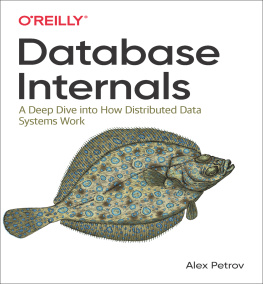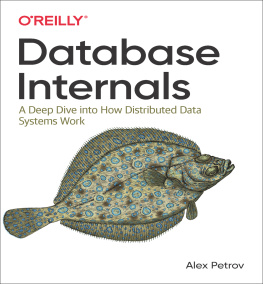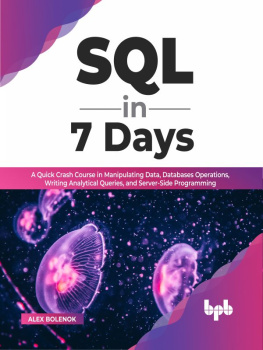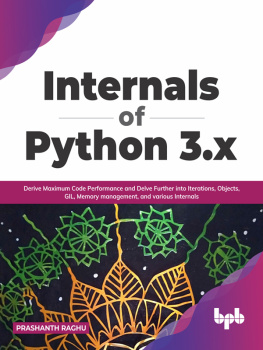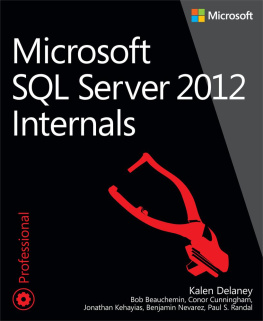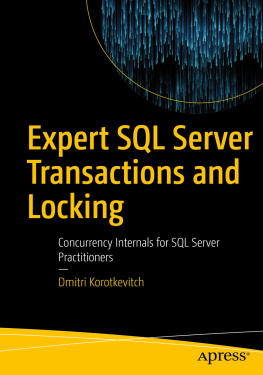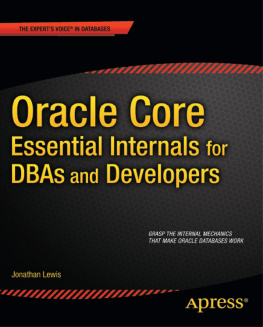Alex Petrov - Database Internals
Here you can read online Alex Petrov - Database Internals full text of the book (entire story) in english for free. Download pdf and epub, get meaning, cover and reviews about this ebook. year: 2019, publisher: OReilly Media, genre: Home and family. Description of the work, (preface) as well as reviews are available. Best literature library LitArk.com created for fans of good reading and offers a wide selection of genres:
Romance novel
Science fiction
Adventure
Detective
Science
History
Home and family
Prose
Art
Politics
Computer
Non-fiction
Religion
Business
Children
Humor
Choose a favorite category and find really read worthwhile books. Enjoy immersion in the world of imagination, feel the emotions of the characters or learn something new for yourself, make an fascinating discovery.
- Book:Database Internals
- Author:
- Publisher:OReilly Media
- Genre:
- Year:2019
- Rating:5 / 5
- Favourites:Add to favourites
- Your mark:
- 100
- 1
- 2
- 3
- 4
- 5
Database Internals: summary, description and annotation
We offer to read an annotation, description, summary or preface (depends on what the author of the book "Database Internals" wrote himself). If you haven't found the necessary information about the book — write in the comments, we will try to find it.
Database Internals — read online for free the complete book (whole text) full work
Below is the text of the book, divided by pages. System saving the place of the last page read, allows you to conveniently read the book "Database Internals" online for free, without having to search again every time where you left off. Put a bookmark, and you can go to the page where you finished reading at any time.
Font size:
Interval:
Bookmark:
by Alex Petrov
Copyright 2019 Oleksandr Petrov. All rights reserved.
Printed in the United States of America.
Published by OReilly Media, Inc. , 1005 Gravenstein Highway North, Sebastopol, CA 95472.
OReilly books may be purchased for educational, business, or sales promotional use. Online editions are also available for most titles (http://oreilly.com). For more information, contact our corporate/institutional sales department: 800-998-9938 or corporate@oreilly.com .
- Acquisitions Editor: Mike Loukides
- Development Editor: Michele Cronin
- Production Editor: Christopher Faucher
- Copyeditor: Kim Cofer
- Proofreader: Sonia Saruba
- Indexer: Judith McConville
- Interior Designer: David Futato
- Cover Designer: Karen Montgomery
- Illustrator: Rebecca Demarest
- October 2019: First Edition
- 2019-09-12: First Release
See http://oreilly.com/catalog/errata.csp?isbn=9781492040347 for release details.
The OReilly logo is a registered trademark of OReilly Media, Inc. Database Internals, the cover image, and related trade dress are trademarks of OReilly Media, Inc.
The views expressed in this work are those of the author, and do not represent the publishers views. While the publisher and the author have used good faith efforts to ensure that the information and instructions contained in this work are accurate, the publisher and the author disclaim all responsibility for errors or omissions, including without limitation responsibility for damages resulting from the use of or reliance on this work. Use of the information and instructions contained in this work is at your own risk. If any code samples or other technology this work contains or describes is subject to open source licenses or the intellectual property rights of others, it is your responsibility to ensure that your use thereof complies with such licenses and/or rights.
978-1-492-04034-7
[MBP]
To Pieter Hintjens, from whom I got my first ever signed book:
an inspiring distributed systems programmer, author, philosopher, and friend.
Distributed database systems are an integral part of most businesses and the vast majority of software applications. These applications provide logic and a user interface, while database systems take care of data integrity, consistency, and redundancy.
Back in 2000, if you were to choose a database, you would have just a few options, and most of them would be within the realm of relational databases, so differences between them would be relatively small. Of course, this does not mean that all databases were completely the same, but their functionality and use cases were very similar.
Some of these databases have focused on horizontal scaling (scaling out)improving performance and increasing capacity by running multiple database instances acting as a single logical unit: Gamma Database Machine Project, Teradata, Greenplum, Parallel DB2, and many others. Today, horizontal scaling remains one of the most important properties that customers expect from databases. This can be explained by the rising popularity of cloud-based services. It is often easier to spin up a new instance and add it to the cluster than scaling vertically (scaling up) by moving the database to a larger, more powerful machine. Migrations can be long and painful, potentially incurring downtime.
Around 2010, a new class of eventually consistent databases started appearing, and terms such as NoSQL, and later, big data grew in popularity. Over the last 15 years, the open source community, large internet companies, and database vendors have created so many databases and tools that its easy to get lost trying to understand use cases, details, and specifics.
The Dynamo paper , published by the team at Amazon in 2007, had so much impact on the database community that within a short period it inspired many variants and implementations. The most prominent of them were Apache Cassandra, created at Facebook; Project Voldemort, created at LinkedIn; and Riak, created by former Akamai engineers.
Today, the field is changing again: after the time of key-value stores, NoSQL, and eventual consistency, we have started seeing more scalable and performant databases, able to execute complex queries with stronger consistency guarantees.
In conversations at technical conferences, I often hear the same question: How can I learn more about database internals? I dont even know where to start. Most of the books on database systems do not go into details of storage engine implementation, and cover the access methods, such as B-Trees, on a rather high level. There are very few books that cover more recent concepts, such as different B-Tree variants and log-structured storage, so I usually recommend reading papers.
Everyone who reads papers knows that its not that easy: you often lack context, the wording might be ambiguous, theres little or no connection between papers, and theyre hard to find. This book contains concise summaries of important database systems concepts and can serve as a guide for those whod like to dig in deeper, or as a cheat sheet for those already familiar with these concepts.
Not everyone wants to become a database developer, but this book will help people who build software that uses database systems: software developers, reliability engineers, architects, and engineering managers.
If your company depends on any infrastructure component, be it a database, a messaging queue, a container platform, or a task scheduler, you have to read the project change-logs and mailing lists to stay in touch with the community and be up-to-date with the most recent happenings in the project. Understanding terminology and knowing whats inside will enable you to yield more information from these sources and use your tools more productively to troubleshoot, identify, and avoid potential risks and bottlenecks. Having an overview and a general understanding of how database systems work will help in case something goes wrong. Using this knowledge, youll be able to form a hypothesis, validate it, find the root cause, and present it to other project maintainers.
This book is also for curious minds: for the people who like learning things without immediate necessity, those who spend their free time hacking on something fun, creating compilers, writing homegrown operating systems, text editors, computer games, learning programming languages, and absorbing new information.
The reader is assumed to have some experience with developing backend systems and working with database systems as a user. Having some prior knowledge of different data structures will help to digest material faster.
We often hear people describing database systems in terms of the concepts and algorithms they implement: This database uses gossip for membership propagation (see ).
We need abstractions to discuss complex concepts, and we cant have a discussion about terminology every time we start a conversation. Having shortcuts in the form of common language helps us to move our attention to other, higher-level problems.
One of the advantages of learning the fundamental concepts, proofs, and algorithms is that they never grow old. Of course, there will always be new ones, but new algorithms are often created after finding a flaw or room for improvement in a classical one. Knowing the history helps to understand differences and motivation better.
Learning about these things is inspiring. You see the variety of algorithms, see how our industry was solving one problem after the other, and get to appreciate that work. At the same time, learning is rewarding: you can almost feel how multiple puzzle pieces move together in your mind to form a full picture that you will always be able to share with others.
Font size:
Interval:
Bookmark:
Similar books «Database Internals»
Look at similar books to Database Internals. We have selected literature similar in name and meaning in the hope of providing readers with more options to find new, interesting, not yet read works.
Discussion, reviews of the book Database Internals and just readers' own opinions. Leave your comments, write what you think about the work, its meaning or the main characters. Specify what exactly you liked and what you didn't like, and why you think so.

